- General features
- Air Quality Station node
- Weather station (optional)
- Noise Level Sensor Class 2 (optional)
- Particulate matter (optional)
Air Quality Station node
General features
Technical specifications
The Air Quality Station node is composed of several parts:
- Air Quality Station Core
- Air Quality Station Sensor Cartridge
- Air Quality Station external temperature and humidity sensor
- Optional sensors:
- Particulate Matter
- Weather station
- Noise Level Sensor Class 2 (Indoors and Outdoors versions)

The next table shows the device features:
| Dimensions | 271 x 170 x 120 mm |
| Weight | 2.152 kg |
| Power supply | 100-240 VAC, 50/60 Hz 0.35A |
| Backup battery | 2200 mAh, Li-SOCl2 battery |
| Gas sensors | SO2, O3, NO, NO2, CO |
| Sensors | External and internal temperature External and internal humidity Atmospheric pressure |
| Particulate Matter (optional) | PM1, PM2.5, PM10 |
| Weather Station (optional) | Wind, compass, precipitation, temperature, humidity, pressure and solar radiation |
| Noise sensor (optional) | Class 2 soundmeter IEC 61672 |
| Loop time | 1, 5, 10, 15, 30, 60 min (1 min default) |
| Radio protocol | LTE |
| SIM | Libelium SIM included |
| GNSS | GPS, BeiDou, Galileo and GLONASS |
| Operating temperature | -30 °C to +45 °C |
| Market certifications | CE (Europe) UKCA (United Kingdom) FCC (USA) IC (Canada) |
| Ingress Protection | IP65 |
Software features:
| Smart Devices App | Desktop application for parameter configuration and firmware upgrade |
| Libelium Cloud | Remote parameter configuration Over The Air firmware upgrade Dashboards External Cloud connectors |
Metrics
R2: A number between 0 and 1. The closer to 1, the better the device imitates the variations of the reference device.
MAE: The mean absolute error (MAE) is a measure of errors between predicted and real values. MAE is calculated as the sum of absolute errors divided by the sample size.
Confidence 90%: This value means that the 90% of the sensor readings are below this error.
The next table shows the average value of the metrics obtained for the Air Quality Station device according to several co-location studies performed to different devices. Before the co-location study, a 1-month co-location calibration process was done to every device using the Libelium Cloud AI services.
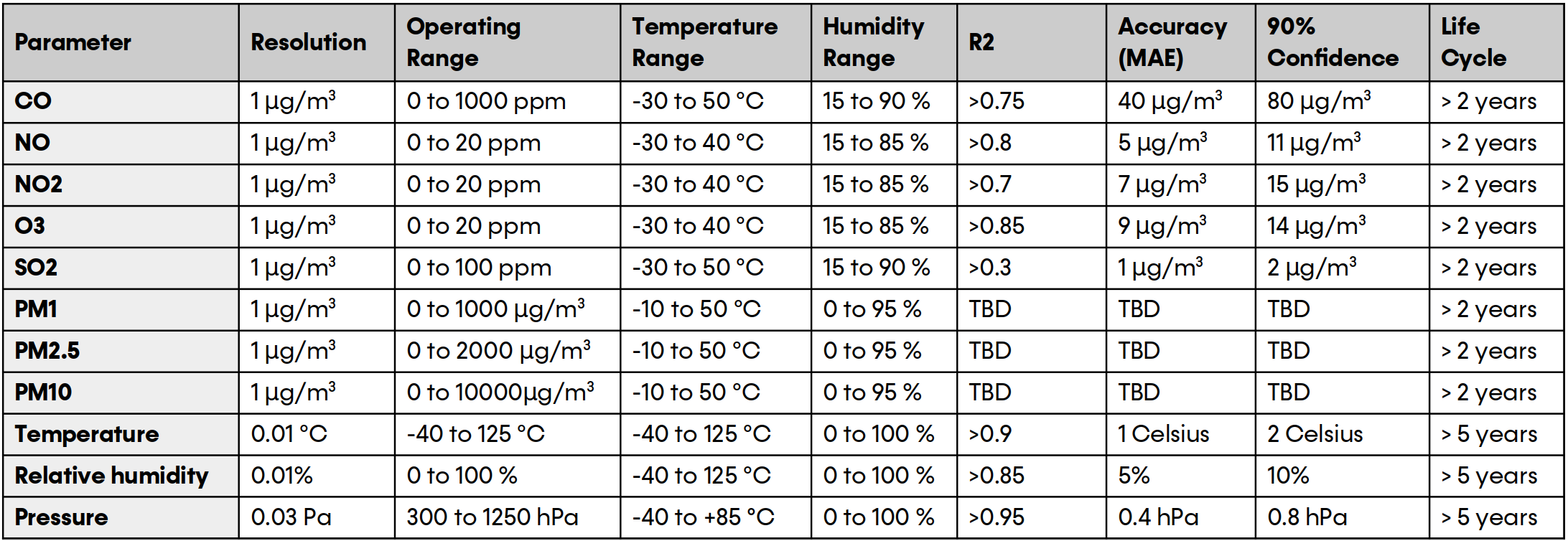
Read how to perform a co-location calibration in the "A.I. Services" section.
Find about co-location studies in the Air Quality Station website.
Air Quality Station node
Enclosure and sticker
The enclosure consists of few parts, so it can be easily mounted by hand. You can open it by means of a screwdriver. When opening the enclosure, it permits a hinged side if required for better management.
PC UL 94 V0 material is suitable for outdoor use (f1 listing acc. to UL 746C and corresponds to requirements set R 22 acc. to DIN EN 45545-2 of hazard level HL3).
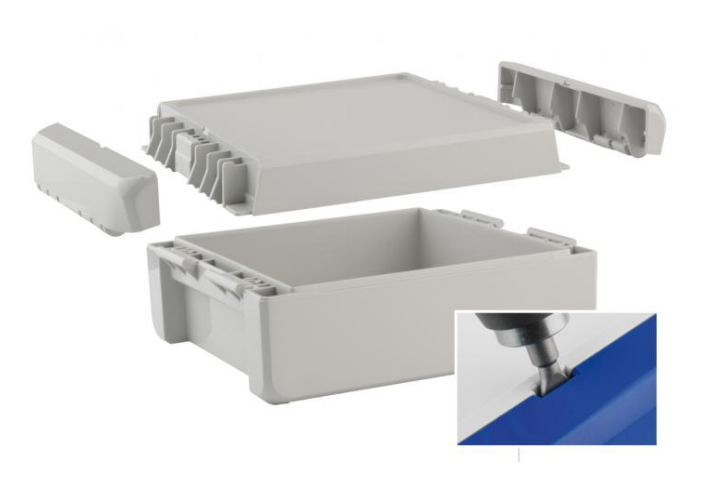
The enclosure comes along with wall brackets to provide an easy installation procedure. They are screwed into the drilling holes on the back of the enclosure base. Wall brackets can also be used to attach flanges and install the device on a different structure as a street lamp or similar.
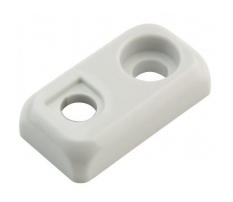
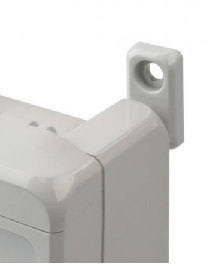
Sticker
In the back side of the enclosure you can find the sticker with the description of the device. It includes the unique Serial ID of the device and the LTE module's IMEI.
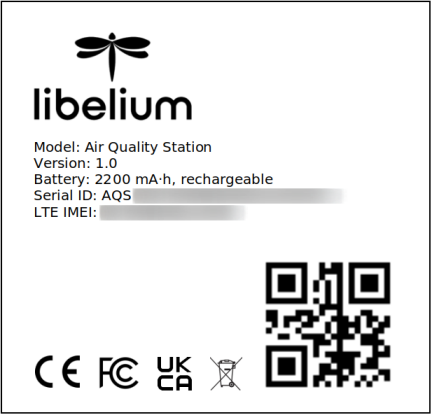
Socket description
The next image describes how the external sensors are plugged into the enclosure:
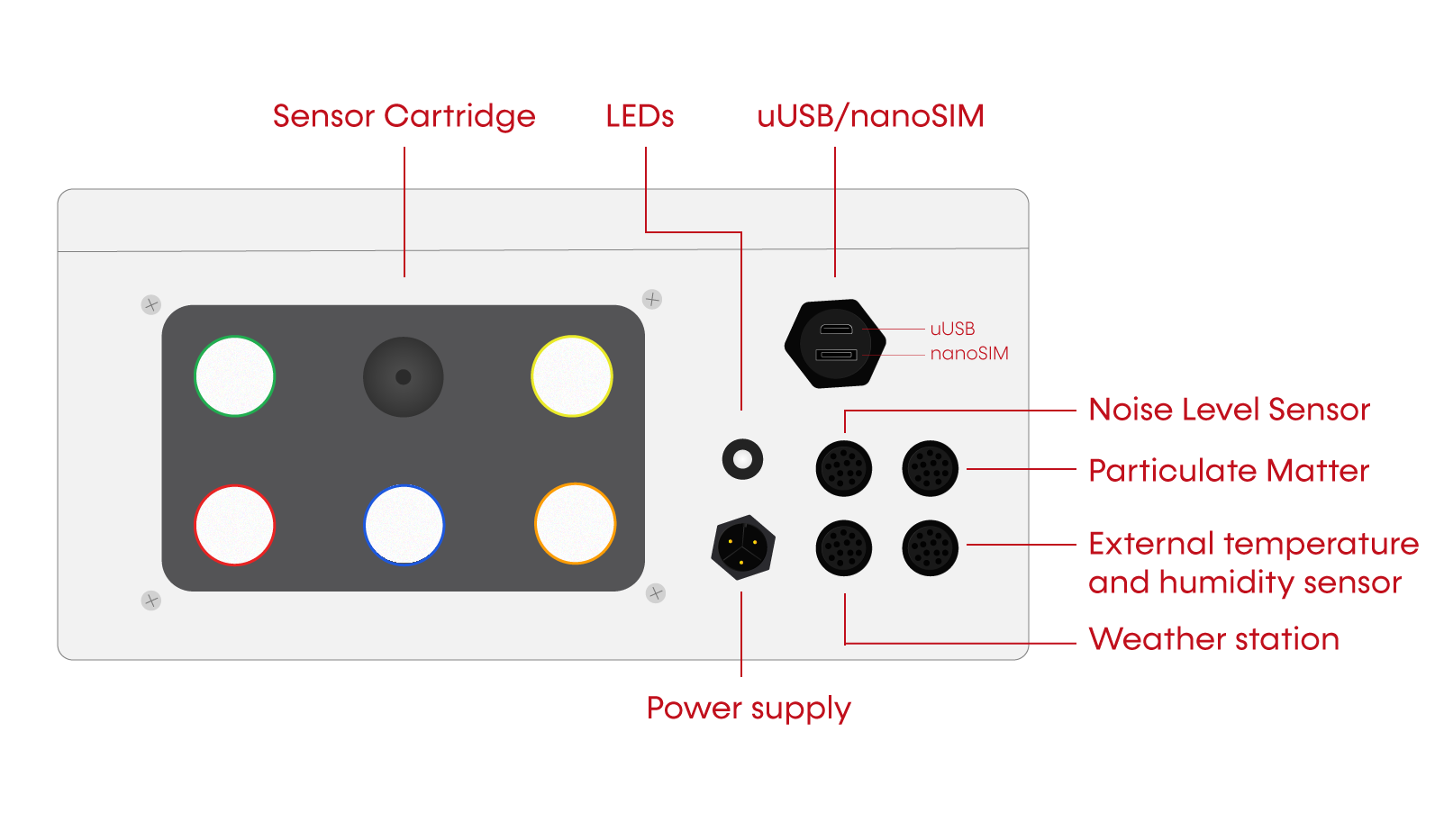
Nano-SIM + Micro-USB socket
The nano-SIM card socket allows the user to insert the SIM card needed for LTE communications. It is not necessary to send a SIM card to Libelium for proper installation. Besides, the nano-SIM card connector has a push-pull mechanism, so it is easy to remove the card with the aid of one nail.

The same socket provides the micro-USB connection. This is intended for in situ parameter configuration purposes or firmware upgrades. These USB operations shall be performed using the Smart Devices App, which is a desktop application.
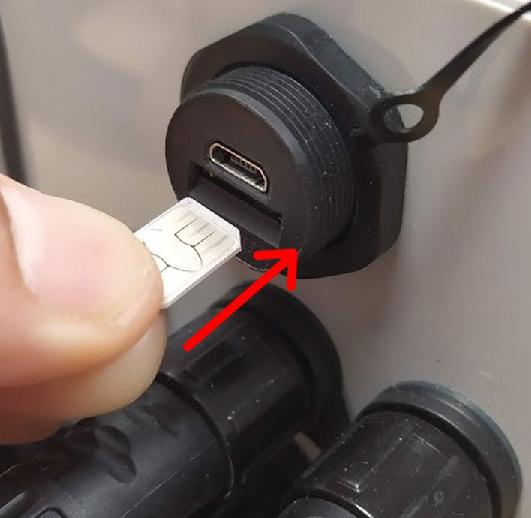
Please mind the correct orientation of the nano-SIM card: the side of the chip must look towards the micro-USB connector, and the 45º-angled corner must face the device
LTE
The LTE Cat 4 module delivers maximum data rates of up to 150 Mbps for downlink and 50 Mbps for uplink. It is backward-compatible with existing EDGE and GSM/GPRS networks, ensuring that it can be connected even in remote areas devoid of 4G or 3G coverage.
| Frequency | Bands |
|---|---|
| LTE-FDD | B1/B2/B3/B4/B5/B7/B8/B12/B13/B18/B19/B20/B25/B26/B28 |
| LTE-TDD | B38/B39/B40/B41 |
| WCDMA | B1/B2/B4/B5/B6/B8/B19 |
| Region | Global |
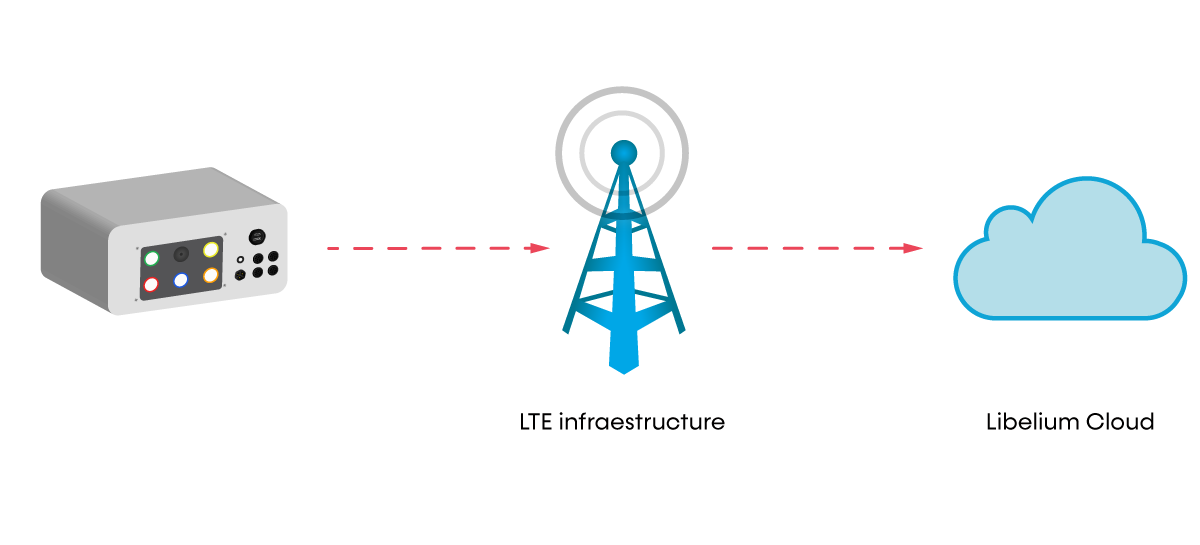
The device sends data to the Libelium Cloud, so the only parameters that must be set in case of using your own SIM card are:
- APN
- Login
- Password
- SIM PIN
To know how to configure LTE parameters, please refer to the "Smart Devices" section.
Gas Sensor Cartridge
The Sensor Cartridge is composed of the gas sensors, the PCB where these gas sensors are plugged and the outdoor protection enclosure. A 2200 mA·h backup battery is attached to the Sensor Cartridge in order to keep the power supply of the gas sensors in case of sudden electricity blackout. Therefore, when power supply is recovered, sensors have maintained their power supply without interruption and measurements are not affected by the electricity blackout. The battery autonomy is 24h.
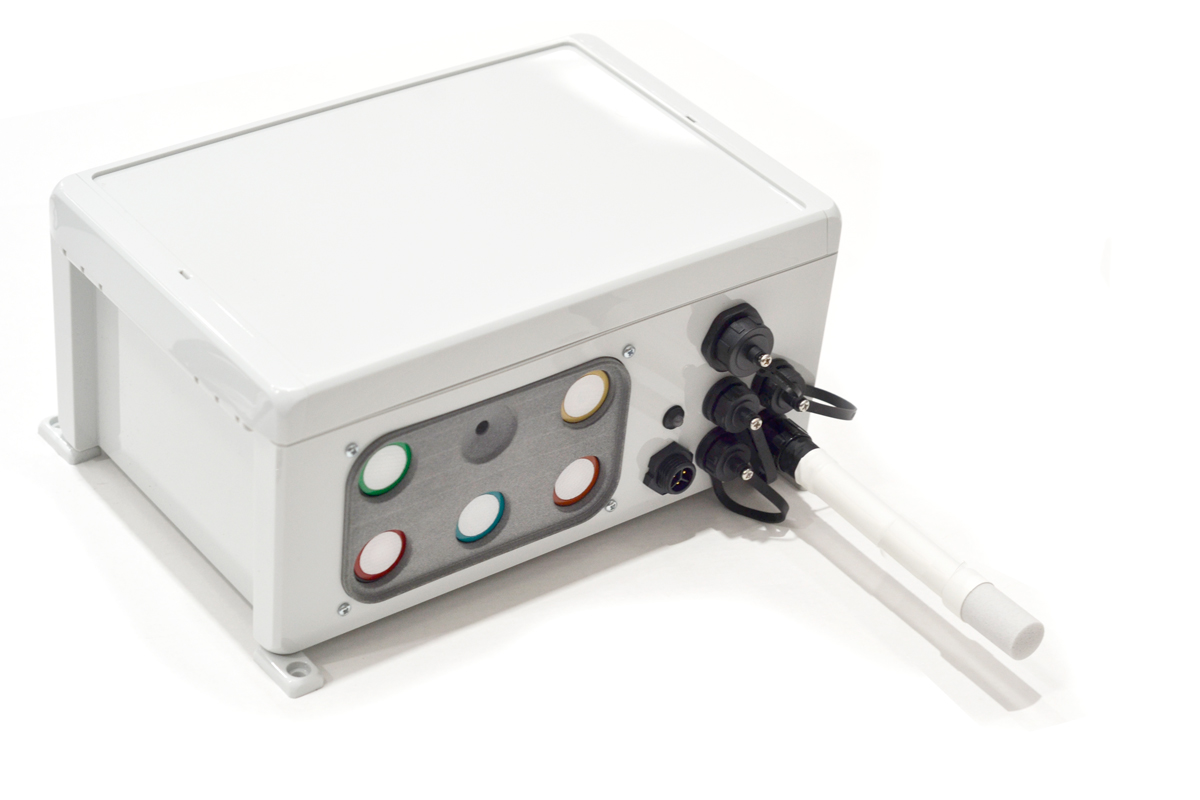
How to replace the Sensor Cartridge
In case of replacement due to sensor deterioration, the Sensor Cartridge can be easily removed and replaced by other unit.
Step 1: Open the enclosure.
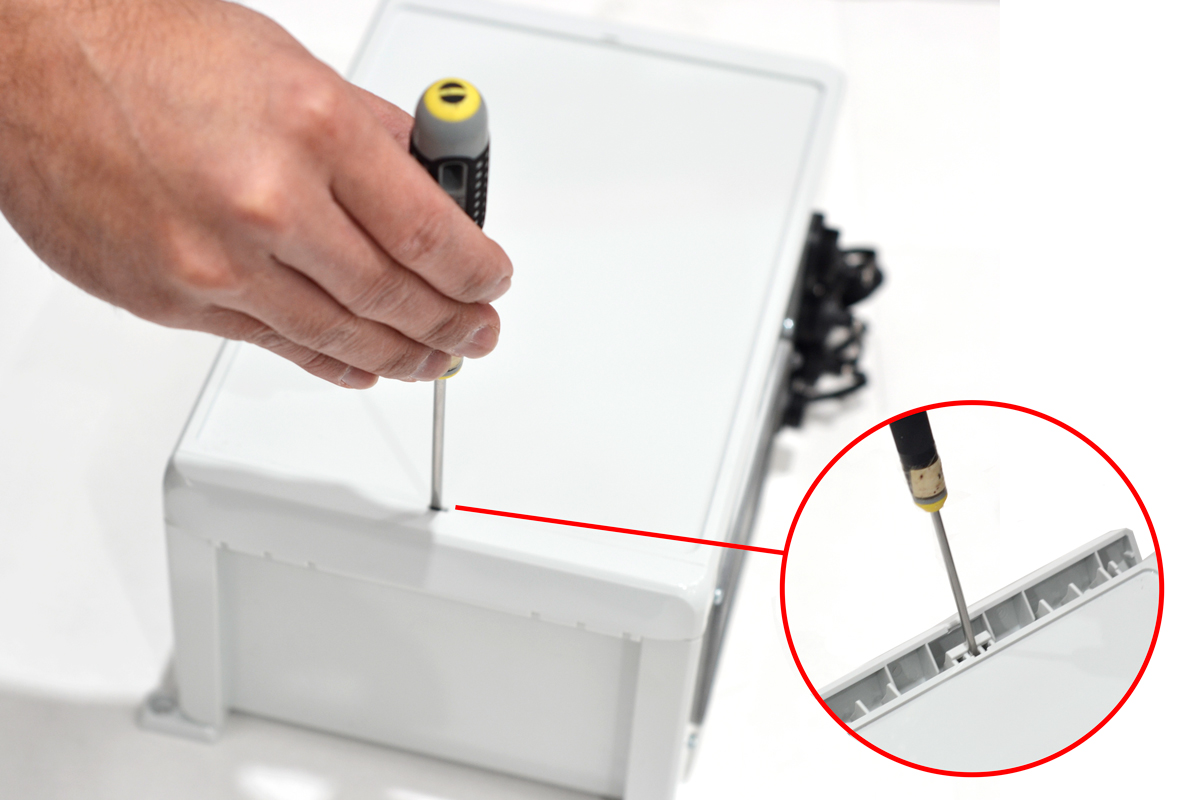
Step 2: Remove the 2 wires that connect the main core board to the Sensor Cartridge board.
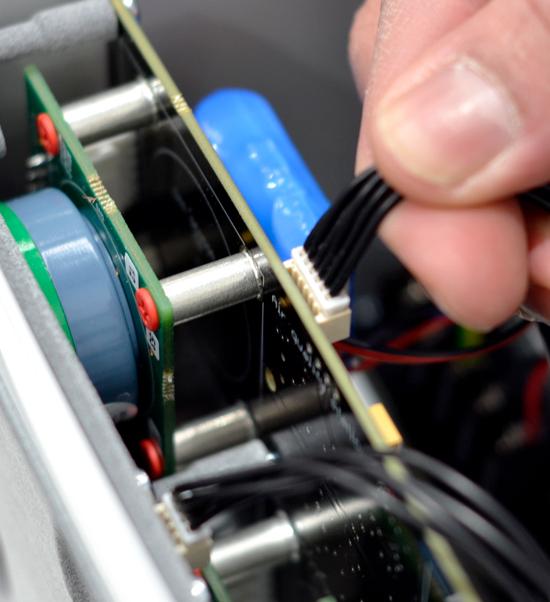
Step 3: Remove the 4 external screws that fix the Sensor Cartridge to the enclosure.
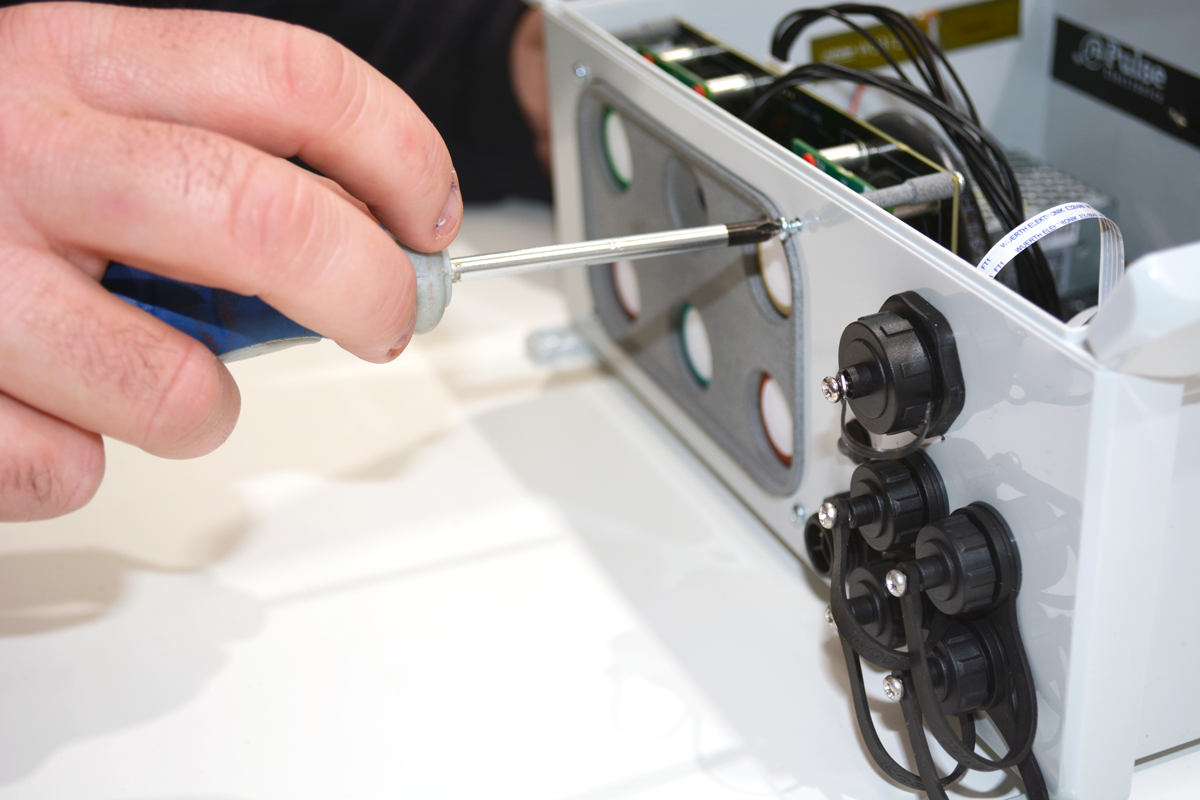
Step 4: Remove the old Sensor Cartridge and place the new one in the same position.
Step 5: Undo the first steps by fixing the cartridge with the 4 screws and connecting the 2 connection wires. Finally, close the enclosure.

CO - Carbon monoxide sensor
| Performance | Value |
|---|---|
| Response time | <25 s from zero to 10 ppm CO |
| Noise | 4 ppb |
| Range | 1000 ppm limit of performance warranty |
| Temperature range | -30 to 50 ºC |
| Humidity range | 15 to 90 %RH continuous |
O3 - Ozone sensor
| Performance | Value |
|---|---|
| Response time | <80 s from zero to 1 ppm O3 |
| Noise | 15 ppb |
| Range | 20 ppm limit of performance warranty |
| Temperature range | -30 to 40 ºC |
| Humidity range | 15 to 85 %RH continuous |
SO2 - Sulfur dioxide sensor
| Performance | Value |
|---|---|
| Response time | <40 s from zero to 2 ppm SO2 |
| Noise | 5 ppb |
| Range | 100 ppm limit of performance warranty |
| Temperature range | -30 to 50 ºC |
| Humidity range | 15 to 90 %RH continuous |
NO - Nitric oxide sensor
| Performance | Value |
|---|---|
| Response time | <45 s from zero to 2 ppm NO |
| Noise | 15 ppb |
| Range | 20 ppm limit of performance warranty |
| Temperature range | -30 to 40 ºC |
| Humidity range | 15 to 85 %RH continuous |
NO2 - Nitrogen dioxide sensor
| Performance | Value |
|---|---|
| Response time | < 60 s from zero to 2 ppm NO2 |
| Noise | 15 ppb |
| Range | 20 ppm limit of performance warranty |
| Temperature range | -30 to 40 ºC |
| Humidity range | 15 to 85 %RH continuous |
Temperature and Humidity sensors
The external SHT35 sensor measures the device's air temperature and humidity.
The internal SHT35 sensor is installed within the Sensor Cartridge next to the gas sensors to track the ambient conditions the sensors are exposed to when the measurements are done.
Specification:
| Humidity parameter | Value |
|---|---|
| Accuracy tolerance | +/- 1.5 %RH |
| Resolution | 0.01 %RH |
| Range | 0 to 100 %RH |
| Long-term drift | <0.25 %RH/year |
| Temperature parameter | Value |
|---|---|
| Accuracy tolerance | +/- 0.1 ºC |
| Resolution | 0.01 ºC |
| Range | -40 to 125 ºC |
| Long-term drift | <0.03 ºC/year |
Atmospheric pressure sensor
Specification:
| Parameter | Value |
|---|---|
| Resolution | 0.03 Pa |
| Absolute accuracy pressyre (typ.) | ± 0.5 hPa |
| Operating range | 300 to 1250 hPa |
| Temperature range | -40 to 125 ºC |
| Humidity range | 0 to 100 % |
| Long-term stability (12 months) | ± 0.33 hPa |
Firmware description
The Air Quality Station node manages different firmwares:
- Bootloader: It is used to load the application firmware when the device is powered on. Also, it performs Over The Air programming tasks.
- Application firmware: It is the main firmware which sets up the device's peripherals (communication and sensors) and then performs an infinite loop consisting on measuring, sending and waiting in idle state to start a new loop.
Weather station (optional)
The device offers the possibility of connecting a MaxiMet weather station manufactured by Gill Instruments.
The MaxiMet series offers a compact solution for weather forecast. The user can choose the best configuration thanks to the modularity that they offer, keeping the robustness, easy installation and low maintenance features.
Parameters related with wind, precipitation, solar radiation, dew point, air temperature, air relative humidity or atmospheric air pressure can be measured with these weather station probes.
Available models:
| Weather station | External temperature and humidity sensor | Precipitation | Temperature, humidity and pressure | Solar radiation |
|---|---|---|---|---|
| GMX-240 | Yes | Yes (only optical) | No | No |
| GMX-550 | Yes | Optional (Tipping bucket accessory needed) | Yes | No |
| GMX-551 | Yes | Optional (Tipping bucket accessory needed) | Yes | Yes |
MaxiMet GMX-240
The MaxiMet GMX-240 is a weather station that provides accurate meteorological information about wind and precipitation (optical method).
Three ultrasonic sensors provide wind speed and direction measurements and the addition of an electronic compass provides apparent wind measurement. Average speed and direction together with WMO averages and gust data are also provided.
An integrated optical rain gauge that senses water hitting its outside surface provides measurements based on the size and number of drops.
The optical rain gauge and the wind ultrasonic sensors have no moving parts so possible mechanical problems are avoided.
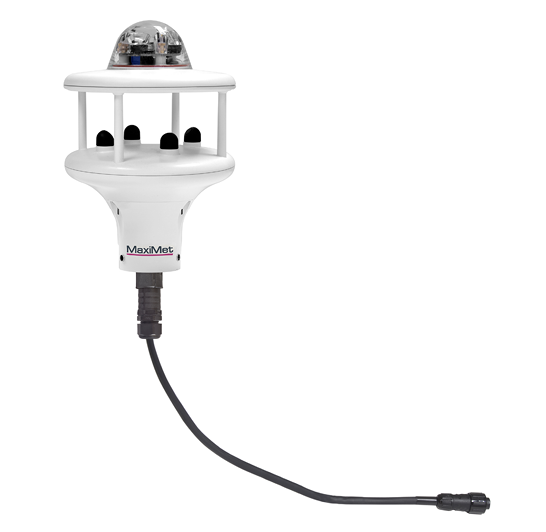
Gill reports their optical precipitation sensor is valid for knowing if it rains. Compact and with low maintenance, it gives a general idea of the amount of rain, but it is not really accurate. Choose the Tipping Bucket for superior accuracy and reliability.
MaxiMet GMX-550
The MaxiMet GMX-550 sensor probe provides accurate information about wind, precipitation (with an accessory), air temperature, air humidity and atmospheric air pressure.
This model is basically a solar shield with no moving parts which allows high performance over large time periods. On the top of the solar shield, 3 ultrasonic sensors are placed to provide wind speed and direction measurements. Besides, an electronic compass provides apparent wind measurement. Average speed and direction together with WMO averages and gust data are also provided. Finally, an inclinometer is also included to allow a precise installation.
On top of that, an integrated connector allows the user to connect a tipping bucket rain gauge to measure precipitation.

MaxiMet GMX-551
The MaxiMet GMX-551 sensor probe provides accurate information about wind, precipitation (with an accessory), air temperature, air humidity, atmospheric air pressure and solar radiation.
This model is basically a solar shield with no moving parts which allows high performance over large time periods. On the top of the solar shield, 3 ultrasonic sensors are placed to provide wind speed and direction measurements. Besides, an electronic compass provides apparent wind measurement. Average speed and direction together with WMO averages and gust data are also provided. Additionally, an integrated pyranometer protected by a single glass measures the solar radiation. Finally, an inclinometer is also included to allow a precise installation.
On top of that, an integrated connector allows the user to connect a tipping bucket rain gauge to measure precipitation.
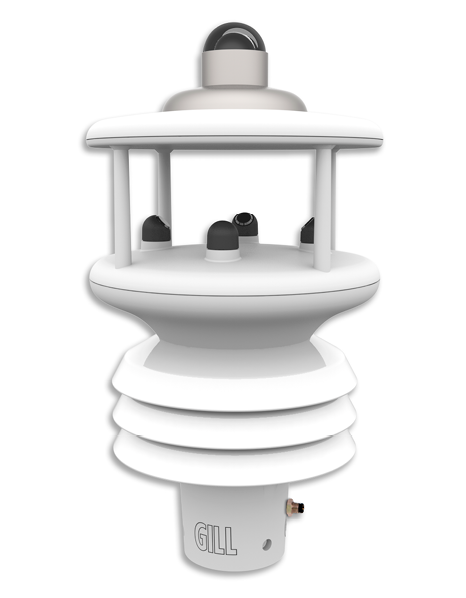
Noise Level Sensor Class 2 (optional)
The Noise Level Sensor Class 2 is a class 2 soundmeter. It complies with IEC 61672-1:2013, ANSI S1.4-1983 and ANSI S1.43-1997.
Specifications of the Sound Level Sensor probe
Target parameter: LeqA, LeqB, LeqC, LeqZ
Microphone sensitivity: 40 mV/Pa
Range of the sensor: 25 dBA to 136 dBA
Accuracy: Class 2
Standards: GB/T 3785.1-2010, GB/T 3785.2-2010, IEC 60651:1979, IEC 60804:2000, IEC 61672-1:2013, ANSI S1.4-1983, ANSI S1.43-1997
Frequency range: 20 Hz -- 12.5 kHz
Omni-directional microphone: it comes in two different hardware versions for indoor and outdoor applications (Noise Level Sensor Class 2 Indoor and Noise Level Sensor Class 2 Outoor)
Frecuency weighting: A, B, C, Z
Specifications of the enclosure
Dimensions: 320 x 100 x 81 mm
Material: Glass fibre reinforced thermoset polyester
Sealing: Silicone
Cover screws: Stainless steel
Ingress protection: IP66
Impact resistance: 7 Joule in reference to EN 60079-0
Heavy metals-free
Ambient temperature (min.): -50 °C
Ambient temperature (max.): +100 °C
Approximated weight: 2070 g
Data cable length: 0.6 m (cable from Noise Level Sensor Class 2 to Plug & Sense!)
Equivalent Continuous Noise Level
The sound pressure level parameter, is not much used in noise measurements. Instead, an average value called Leq, is used. Equivalent Continuous Sound Level ("Leq") is the average of the sound pressure level during a period of time. This value is very used when the noise level is varying quickly.
The Libelium's Noise Level Sensor Class 2 sensor is an optimal sound level meter for measurements at workplaces, construction sites, in traffic, airports, etc. The NLS Class 2 meter is a class 2 device and is equipped with an octave band frequency filter.
The sensor makes use of several weighting curves, defined in the International standard IEC 61672:2003, to read the equivalent continuous noise level providing the LeqA, LeqB, LeqC and LeqZ values.
Besides the equivalent continuous noise level, the sensor provides some other different values such as:
- LN values (percentiles)
- Fast, slow and impulse noise level pressure for A, B, C and Z weighting curves
- Maximum and minimum values amongst the previous ones
- Sound exposure level for A, B, C and Z weighting curves
- Peak values
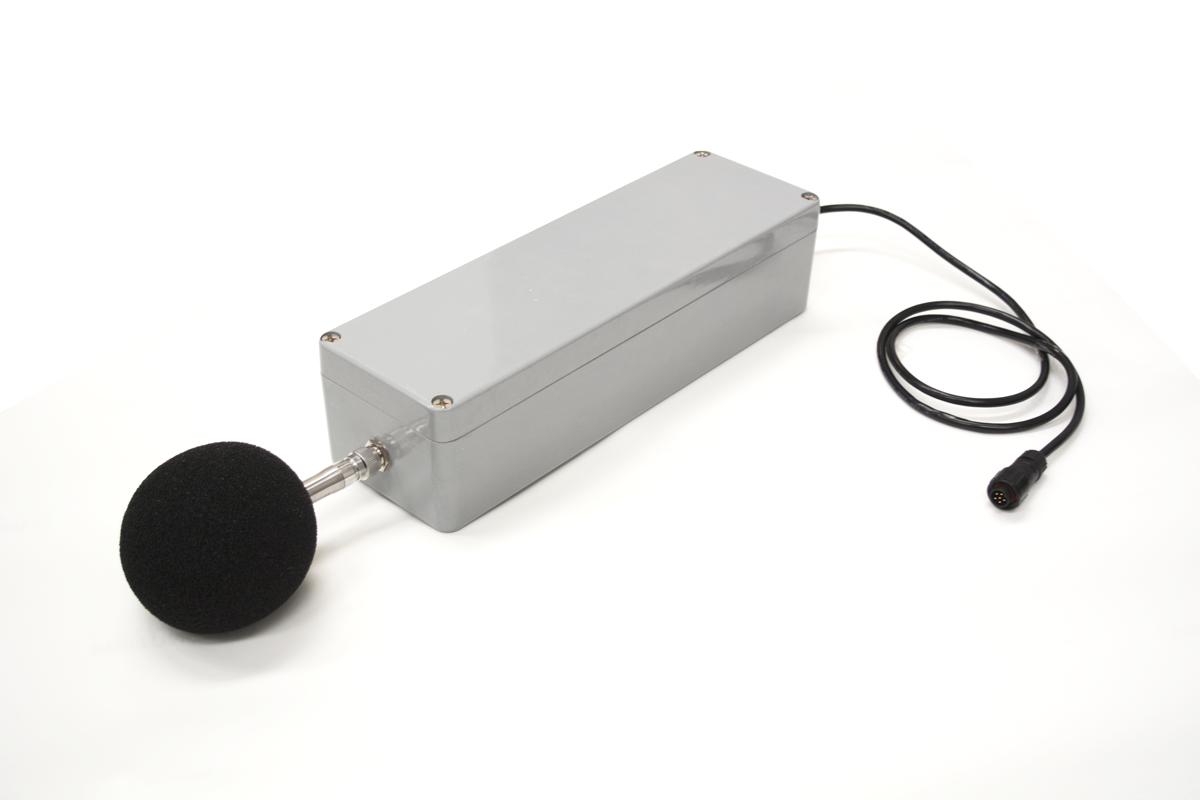
The Noise Level Sensor Class 2 is available in 2 versions: Indoors and Outdoors.
- The Indoors version incorporates a decent, IEC 61672 class 2 microphone. It aims for indoors applications.
- The Outdors version comes with a weatherproof microphone. It is prepared for real-world weather conditions (rain, wind, etc). This microphone meets IEC 61672 class 1 specification (the combination of this microhone with the Noise Level Sensor Class 2 remains class 2). It also provides a 2-meter extension cable, needed for a proper installation. The anti-bird spikes prevent birds from perching on top of it.
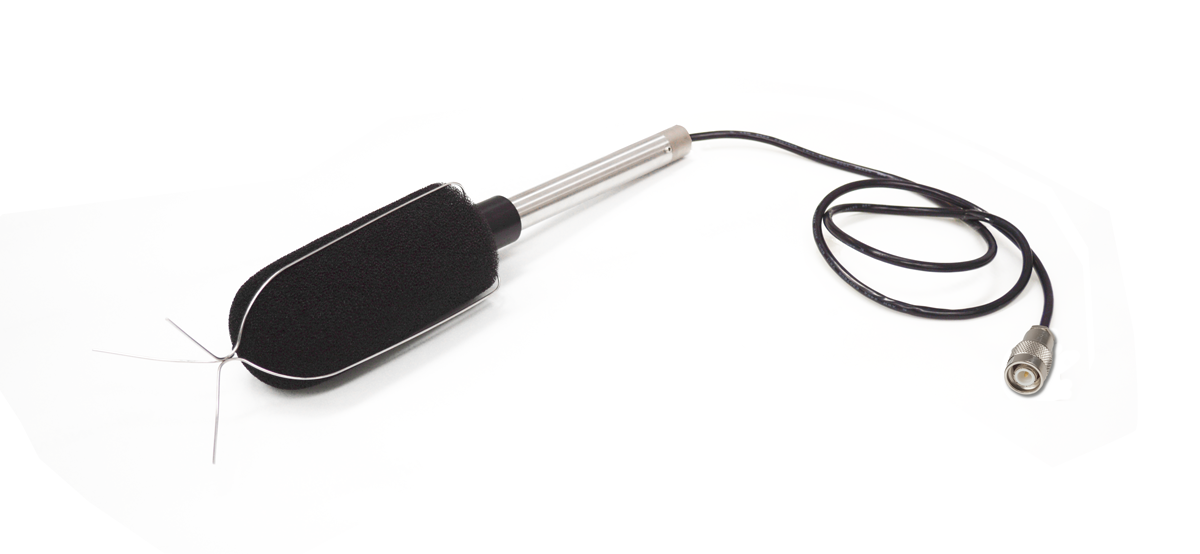
Particulate matter (optional)
Particulate matter is composed of small solid or liquid particles floating in the air. The origin of these particles can be the industrial activity, exhaust fumes from diesel motors, building heating, pollen, etc. These tiny particles enter our bodies when we breath. High concentrations of particle matter can be harmful for humans or animals, leading to respiratory and coronary diseases, and even lung cancer. That is why this is a key parameter for the Air Quality Index.
Particles are classified as follows:
- PM1: Mass (in μg) of all particles smaller than 1 μm, in 1 m³.
- PM2.5: Mass (in μg) of all particles smaller than 2.5 μm, in 1 m³.
- PM10: Mass (in μg) of all particles smaller than 10 μm, in 1 m³.

High humidity or foggy environments could affect the measures of the sensor. The particles can be swollen by or coated by water. This results in measures which are higher than in dry environments.
If high humidity, fog or mist are present, then the sensor will actually measure the water droplets in the air, causing very high readings.